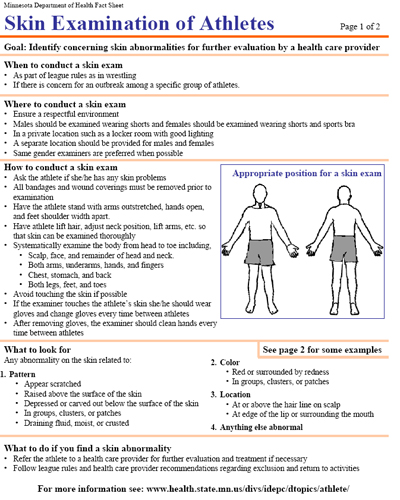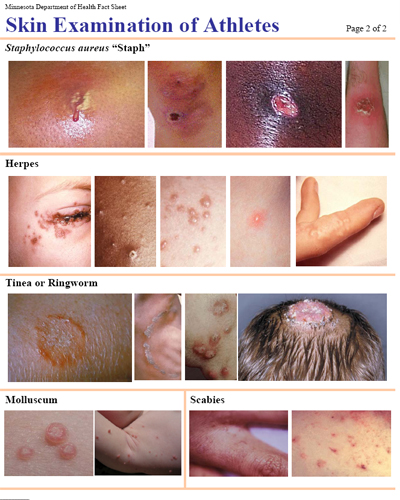Contact Info
Infectious Disease Epidemiology, Prevention and Control Division
651-201-5414
Skin Examination of Athletes
Download a print version of this document:
Skin Examination of Athletes (PDF)


Goal: Identify concerning skin abnormalities for further evaluation by a health care provider.
When to conduct a skin exam
- As part of league rules as in wrestling
- If there is concern for an outbreak among a specific group of athletes
Where to conduct a skin exam
- Ensure a respectful environment
- Males should be examined wearing shorts and females should be examined wearing shorts and sports bra
- In a private location such as a locker room with good lighting
- A separate location should be provided for males and females
- Same gender examiners are preferred when possible
How to conduct a skin exam
- Ask the athlete if she/he has any skin problems
- All bandages and wound coverings must be removed prior to examination
- Have the athlete stand with arms outstretched, hands open, and feet shoulder width apart.
- Have athlete lift hair, adjust neck position, lift arms, etc. so that skin can be examined thoroughly
- Systematically examine the body from head to toe including:
- Scalp, face, and remainder of head and neck.
- Both arms, underarms, hands, and fingers
- Chest, stomach, and back
- Both legs, feet, and toes
- Avoid touching the skin if possible
- If the examiner touches the athlete’s skin she/he should wear gloves and change gloves every time between athletes
- After removing gloves, the examiner should clean hands every time between athletes
What to look for
Any abnormality on the skin related to:
- Pattern
- Appear scratched
- Raised above the surface of the skin
- Depressed or carved out below the surface of the skin
- In groups, clusters, or patches
- Draining fluid, moist, or crusted
- Color
- Red or surrounded by redness
- In groups, clusters, or patches
- Location
- At or above the hair line on scalp
- At edge of the lip or surrounding the mouth
- Anything else abnormal
What to do if you find a skin abnormality
- Refer the athlete to a health care provider for further evaluation and treatment if necessary
- Follow league rules and health care provider recommendations regarding exclusion and return to activities
Page 2 of this fact sheet contains images of Staphylococcus aureus “Staph”, Herpes, Tinea or Ringworm, Molluscum, and Scabies.
Last Updated: 10/05/2022